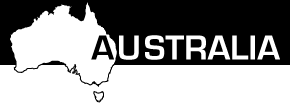 |
|
12.5.02
h: Having skipped a calendar day, we arrived in Sydney with no booked accommodations and despite our business-class pampering on Quantas... inevitably exhausted. After 9 phone calls, Jan found us beds in a King's Cross hostel. A colorful area of town, King's Cross. Sex shops and Internet cafes amidst hostel after hostel. Too tired to do anything but pick a fight with Jan, I went to bed around 5pm - only to wake up tired the next morning a good 13 hours later. Jet lag sucks.
j: While Sydney was not directly on fire, we could certainly smell the smoke from the suburban fires and the cool temperatures and clouds weren't helping, so we decided to head south. That and the fact that my cousin Guido wouldn't be back in Sydney until Dec 18th anyways.
|
|
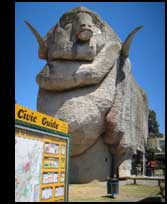 12.7.02
12.7.02
h: 12 hours, one Giant Ram pit stop, and one screeching baby later our bus pulled in to Melbourne. Even the driver was cranky by then - he apparently had this pet peeve about people "chatting" during the microphone announcements and throughout the trip kept interrupting his own announcements to ask people to keep quiet while he was talking and to complain about how rude people can be. The last straw was as we were pulling into Melbourne and someone had the misfortune of receiving a cell phone call during his canned announcment thanking us for choosing Firefly Bus Company. He actually cut himself off mid-thank you to end his final announcement with "Ah, I don't know why I even bother."
We don't know why he bothers either. What a crab.
|
|
 12.8.02
12.8.02
h: Jan and I have been in Australia for a few days now and the jet lag is wearing off. I'm still having dreams about packing stuff, moving stuff, getting rid of stuff... When will I wake up and actually be on the trip? So far it seems most of our time has been spent planning and in pursuit of that which is most like home. Internet, comfortable room, clean toilets. Okay well, the first two are like home, even if the third isn’t.
By and large, Australia just doesn’t seem all that, well, foreign. Commercially at least it seems to have more recognizable stores than does Canada in many respects. Nike, Columbia, to BP and U-Haul. Aussies live in a big space like Americans and I guess it makes sense that their consumer habits would best match ours. It would appear that like Americans they like things large, they like and use a lot of products for outdoor recreation, and they like fast food. McDonald’s, Taco Bell, Pizza Hut, Burger King, Starbucks. Before I left I was in a panic that my lifeline to the English-speaking world was going to be severed ... then we arrive and I discover that the 3-D Space Imax is playing which just left Seattle, Lord of the Rings starts Dec 26, and my book club book is available in pretty much every major bookstore I walk into. Guess I overreacted a bit.
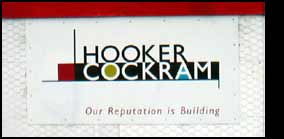 Jan and I have spent most of the last few days in Melbourne hanging out at the hostel, which is quite comfortable really. Large, well-organized kitchen for guest use, small cafeteria if you don't feel like cooking, clean rooms (excepting ours - see photo), and nice showers and bathrooms. It's been a bit hectic here at the hostel over the last few days because they've been hosting a large group of high-school volleyball players here for a tournament. Youths? At a youth hostel? Snort.
Jan and I have spent most of the last few days in Melbourne hanging out at the hostel, which is quite comfortable really. Large, well-organized kitchen for guest use, small cafeteria if you don't feel like cooking, clean rooms (excepting ours - see photo), and nice showers and bathrooms. It's been a bit hectic here at the hostel over the last few days because they've been hosting a large group of high-school volleyball players here for a tournament. Youths? At a youth hostel? Snort.
We haven't done much in Melbourne yet, but having recently left the real estate industry I was particularly interested in some of the construction currently underway. I was pleased to note that unlike American construction companies apparently Australian ones don't take themselves terribly seriously.
|
|
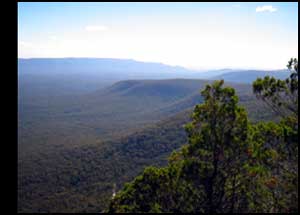
 12.11.02
12.11.02
j: The Grampians.
A lovely bit of forest (actually a big national park) about 3 hours drive west of Melbourne. Lots of tramping (not for us :-), exotic birds, a lovely waterfall, wildlife like wallabies, nice views, and an aboriginal shelter painting locked up behind bars like a zoo animal. I found the eco hostel equally interesting -- only two and a half years old, it looks more like a lodge than a hostel, lots of exposed wood and huge windows, wood-burning fireplaces in the lounges, a chicken coop out back (free fresh eggs in the morning, though we woke up too late for that), an herb garden (we had a taste of the "Vietnamese mint" which was not at all minty, and in fact somewhat hot and strong, a taste that stays in your mouth a while even after drinking some water). My favorite feature, something I thought of several years ago but never saw implemented until now, is that the gray water from the showers is held in a tank and is then used for flushing the toilets. Now that's recycling!
12.11.02
h: The day we drove out to the Grampians was the day I felt the trip really started for me. Somehow the cities of the world all look alike (perhaps why I like them? you can always go see a film, get a cup of coffee, look at a museum) but drive out to the countryside of any country and you start to see a little about where you really are. It's like driving back in time; rural places reveal what the place looked like before the world globalized and a city looked like a city looked like a city.
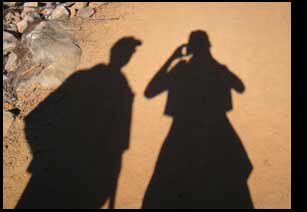 Long stretches of the highway looked to me like pictures I've seen of Africa almost - save the sheep scattered everywhere like clouds of gray fluff dotting the landscape in clumps and clusters. The first and only kangaroo I've seen so far was a dead and rotting one on the side of the road (nice) but the birds have been spectacular. Seems everywhere you go, even the driest parts, birdsong envelops you - loud squawks to soft coos and everything in between. There's the bright blue ones that are tiny like sparrows and are typically accompanied by 2-3 plain brown females. Then there's the laughing kookaburras, the black and white magpies and many more we could only hear and barely see, much less identify. Huge flocks of white birds flew through the canyons of Hall's Gap both at night and again in the morning as we left, a scene reminiscent of Hitchcock. Bird birds birds. I looked at but did not purchase a bird guide before we left and sincerely regretted it.
Long stretches of the highway looked to me like pictures I've seen of Africa almost - save the sheep scattered everywhere like clouds of gray fluff dotting the landscape in clumps and clusters. The first and only kangaroo I've seen so far was a dead and rotting one on the side of the road (nice) but the birds have been spectacular. Seems everywhere you go, even the driest parts, birdsong envelops you - loud squawks to soft coos and everything in between. There's the bright blue ones that are tiny like sparrows and are typically accompanied by 2-3 plain brown females. Then there's the laughing kookaburras, the black and white magpies and many more we could only hear and barely see, much less identify. Huge flocks of white birds flew through the canyons of Hall's Gap both at night and again in the morning as we left, a scene reminiscent of Hitchcock. Bird birds birds. I looked at but did not purchase a bird guide before we left and sincerely regretted it.
As forests go, The Grampians are among the nicest I've seen in the world. The trees are largely eucalyptus and smell wonderful, especially when it rains. The overlook, in the picture shown above, makes you feel as though you're standing on the edge of time.
|
|
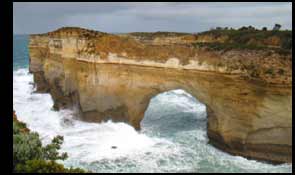 12.13.02
12.13.02
j: The Great Ocean Road.
Spectacular coastline drive (one of the world's best) which would have been doubly impressive in the sunshine. Huge 100' (30m) tall limestone cliffs pounded by large waves from the sea (coming unfettered from Antarctica) over millenia, shaped into columns, arches and outcroppings.
No shortage of tour buses either. Cold strong winds. Despite those clouds with occasional sunbreaks, I managed to get a wicked facial and neck sunburn.
12.13.02
 h: The guide book said that the Great Ocean Road is one of "the most spectacular ocean drives in the world" and I would have to agree. Not that I've seen that many, but it's pretty amazing.
h: The guide book said that the Great Ocean Road is one of "the most spectacular ocean drives in the world" and I would have to agree. Not that I've seen that many, but it's pretty amazing.
I guess the part that left the strongest impression for me was standing atop a limestone cliff and squinting out at the ocean horizon, icy wind and rain stinging my eyes and face. Nothing between this coastline I'm standing on and Antartica. I thought of Shackleton who's achieved so much notoriety lately and tried to imagine spending days and days in a tiny wooden boat fighting waves as large or larger than these and even colder winds. It sent a shiver through my spine to think of it; I got back in the car. For those of you with the mistaken impression that Jan and I are already happily swimming in the bathtub waters of sunny Australia... well, I thought I would be too by now. Brrr. Not these beaches, not for me anyway.
The ocean and limestone formations are beautiful but the countryside near the coast is equally so. Lush, green... some of it farmland for dairy cattle and some of it rainforest. We saw koalas along the coast (they sleep in the trees along one of the roads during the daytime, apparently uninterested in the tourists who get out of their cars to stare at them and snap photos) and we were also treated to a sighting of another exotic species, such a sweet face...
|
|
|
12.14.02
h: Well we returned to Melbourne
and our website is finally up! Whew!
The weather has finally gone sunny on us and I was able to
wear shorts for the first time on our excursion to the Melbourne Royal
Botanical Gardens. Apparently to put oneself on the map as a town in Australia,
one must have a teahouse with takeaway hot meals, a petrol station, and a Royal
Botanical Garden. Melbourne,however, is apparently world renown for its gardens. For what, the guidebook is
not clear, but anything world renown is on our list. So off we went on a fine
Sunday. (fine is the Aussie word for “clear and sunny”).
The gardens were impressively large, but other than that we
weren’t terribly interested in the trees and plants. And strangely enough, the
one cool thing about them wasn’t in the guidebook at all … BATS. That’s right,
bats. The center of the gardens is the daytime home to thousands of fruit bats.
The trees in the tropical rainforest section of the garden are their sleeping
roosts during the day and at night they fly out across the city saving its
occupants from insects great and small. How gothic.
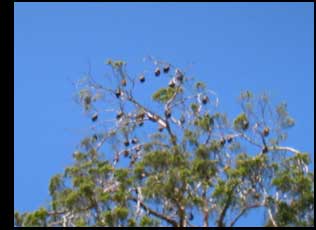 I could have watched these things for days, literally.
Doesn’t sound all that interesting? Some bats sleeping in some trees? As the
one of the gardens’ park rangers put it, “Some of them are sleeping and some of
them are just sort of pretending to be asleep.” Indeed. You can stand under the
trees and look straight up at them while they flap and screech and bicker and
fuss and it makes quite a racket. Occasionally one or several will get chased
from the treetop they have chosen and will flap across the lawns directly
overhead to find a new branch to hang from in an adjacent tree. When they perch/land/roost
– what exactly do bats do?, it’s also quite dramatic. They sort of swing in and
use their feet to grab hold of the branch they’ve chosen, sending the whole
side of the treetop violently rocking and swaying. This tends to be where the
squabbles start up since they often choose a branch to grab hold of that is
already home to 3 or 4 other sleeping bats.
I could have watched these things for days, literally.
Doesn’t sound all that interesting? Some bats sleeping in some trees? As the
one of the gardens’ park rangers put it, “Some of them are sleeping and some of
them are just sort of pretending to be asleep.” Indeed. You can stand under the
trees and look straight up at them while they flap and screech and bicker and
fuss and it makes quite a racket. Occasionally one or several will get chased
from the treetop they have chosen and will flap across the lawns directly
overhead to find a new branch to hang from in an adjacent tree. When they perch/land/roost
– what exactly do bats do?, it’s also quite dramatic. They sort of swing in and
use their feet to grab hold of the branch they’ve chosen, sending the whole
side of the treetop violently rocking and swaying. This tends to be where the
squabbles start up since they often choose a branch to grab hold of that is
already home to 3 or 4 other sleeping bats.
Jan estimates they are perhaps 3 feet from wing tip to wing
tip – I would guess a little smaller than that but regardless they are easily 2
feet from tip to tip. Which is a pretty large thing to watch flutter maybe
15-20 feet above your head. I’ve been to many zoos but this is by far my
coolest encounter with these amazing rats with wings. And to think there’s no
mention at all in the guidebook. Shocking.
The bats showed up in the early 1980s and everyone thought
that was groovy until they started pooping all over the garden plants and
biting tourists. (hee hee – there are signs on the walkways warning people to
report any bites). The keepers of the gardens are apparently working to
relocate the bats, pity really. We really enjoyed watching the little fellas.
Unfortunately, the whole occasion didn’t photograph all that well. We tried.
|
|
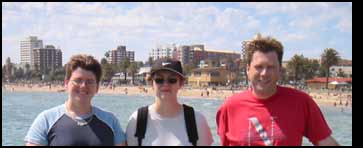 12.15.02
12.15.02
h: We spent today on a guided walking tour by the lovely Sonya and Paul Houlihan. I met Sonya about 5 years ago (is that what we figured out?) when I first arrived in Vancouver, BC. She was just finishing her trip and had a single day to spend in Vancouver; I was just starting my work abroad time there. We tore up Stanley Park and finished up the day with a few beers.
Sonya and I had kept in touch until a couple years ago when the occasional emails had dropped off altogether. When Jan and headed for Australia I dropped her an email to see if she could still be reached and if she'd like to catch up while we were in town.
And, so what did we do on our tour? We ate a lot. hee hee. Started wandering the shops and Sunday markets in the Southbank complex next to the Yarra river then a bite of lunch in an extremely hot but tasty bistro called Blue Train Cafe. Then took the streetcar (yes, streetcars - Melbourne's main public transportation in downtown. Jan and I seem to think the Seattle waterfront streetcar was purchased from Melbourne awhile back) to St. Kilda for a look at the beach and some Jewish bakeries for another bite to eat... yummy. You can feel your blood sugar rising and hips spreading just to look in the windows of these fabulous bakeries.
After a pleasant day of lots of sun, walking, and too much eating we were all bit wiped out and decided to call it a day.
|
|
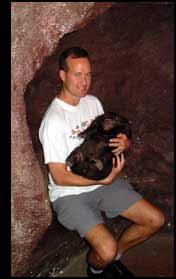 12.16.02
12.16.02
j: Phillip Island and the Penguin Parade.
A day trip that included a stop at a winery, a wildlife park where I cuddled a wombat (like a cute ugly baby :-) and hand-fed kanagaroos with soft muzzles (including one with claws that could rip you apart), a koala sanctuary where we could observe these cute creatures doing what they do best -- sleeping 20 hours a day (rough life!), and above all the famous Penguin Parade at dusk. Unfortunately photography of the penguins was not allowed, which of course didn't stop me, but without a flash the photos are rather hard to see. Picture if you will several hundred little one-foot-tall fairy penguins (in groups of about 80 at a time) popping out of the sea onto the beach and waddling right past our stand into their burrows on the hills surrounding us. Interestingly, the first group to come out of the water decided several times that it was too light out and returned back into the sea for a few minutes to try again, teasing the onlookers.
|
|
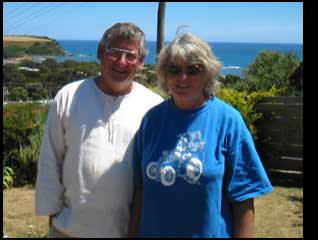 12.18.02
12.18.02
j: Ferry to Tasmania.
A large newer cruise-like vessel (think chandeliers, a closed pool and spa on the rooftop deck, several bars including one with a disco ball) that now travels twice daily for the 9 hour crossing between Melbourne and Devonport on the northern coast of Tas. And the cutest food-sniffing beagle when disembarking in Tas. Why Tas you ask? Because of the tasmanian devil! Actually we didn't even see one of the little carnivorous marsupials... the real reason was to see a friend's hometown area, meet her parents and borrow her car (budgets will be budgets ;-). I met Joanna, a Tassie native, on the Big Island of Hawaii in early 2000 when she was about two weeks into her round-the-world trip, having gotten rid of her apartment and stored things including her car at her parents' house (sound familiar?). Well, as it turns out Joanna is still working in Scotland and loving it, despite the as-rainy-as-Seattle weather. So Joanna generously offered use of her car, and her parents generously picked us up at the ferry terminal and were most excellent hosts for two days. I must say Bob and Ann were very friendly and fun to talk to, a genetic Australian trait it would seem.
h: The ferry was very luxurious for a ferry, and ride over was very smooth. Apparently, unbeknownst to us, there is a very strict quarantine for entry to Tasmania. The island has rich red volcanic soils and are producers of a great range of agricultural products we later discovered. As they are a somewhat remote island, they have managed thus far to avoid most of our major crop and animal diseases and pests. The Japanese are among the countries that purchase Tasmania's exports and the Japanese are apparently very selective about the produce they purchase. Tasmania is one of the few places they will import from and since they pay quite well for the produce, the Tasmanians go to great lengths to quarantine so that they may keep the island free of disease and pests.
At any rate, this is relevant because we had just gone to the Victoria Market in Melbourne and loaded up on all kinds of delicious produce for our journey on the ferry... which led us to eating all the produce on the trip since we'd have to throw it out on our arrivial. They did, however, let us keep the cake we'd brought as a token offering to our hosts in Devonport - a lovely and moist orange and almond cake with tasty frosting.
Bob and Ann Foulkes, Joanna's parents, met us at the ferry with their dog Suzie as the red carnation in the lapel, so-to-speak. As Jo is still in Scotland, her parents were extremely kind in greeting, orienting, and giving us a bed for a couple nights before we did our car tour of this amazing island.
|
|
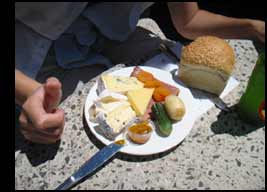 12.19.02
12.19.02
j: Tasmanian Northwest Coast.
We hopped into Jo's car (uh oh, a stickshift on the left side of the road!) with heather singing the "keep left, keep left" mantra per Jo's instructions. A beautiful, scenic coast right out of the gate from Devenport, but first a diversion to the local cheese factory called Lactos in the town of Burnie for sampling. Mmm, at least two dozen types of cheese to sample, then we bought a tasty cheese-laden lunch and four chunks of cheese for the road. The company had been bought out by the French in the early 19th century, after which the quality improved considerably, and equally importantly, they began producing soft cheeses too. My personal favorite was the peppercorn camembert. We drove all the way to the western coast to a nice beach with a rocky tidal pool section. Looking west over the water, there is actually no land until the tip of South America, and then no land until New Zealand, and then the other coast of Tasmania (at this latitude of about 44° south).
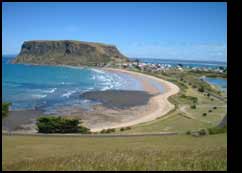 h: Jo's instructions included a mantra, but her dad's instructions required that Jan "Keep Heather in the gutter." Very nice. Hee hee. Jan did an excellent job with the driving, which was fortunate because today is the day that I came down with a nasty headcold. The rest of the island, while I will remember is very lovely, is something of a drugged blur for me. Think: small car, varying elevations, sinus congestion. Ouch. Anyway, Jan doesn't do this cheese factory justice, I don't think. I think I must have died and gone to heaven. 15 or so kinds to sample and then lunch to follow? Pure delight.
h: Jo's instructions included a mantra, but her dad's instructions required that Jan "Keep Heather in the gutter." Very nice. Hee hee. Jan did an excellent job with the driving, which was fortunate because today is the day that I came down with a nasty headcold. The rest of the island, while I will remember is very lovely, is something of a drugged blur for me. Think: small car, varying elevations, sinus congestion. Ouch. Anyway, Jan doesn't do this cheese factory justice, I don't think. I think I must have died and gone to heaven. 15 or so kinds to sample and then lunch to follow? Pure delight.
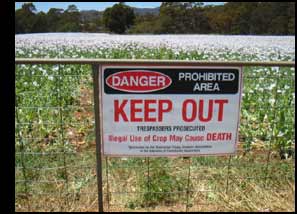 The driving we today was largely through farm country and there were two crops in bloom at the moment. One is a small white flower whose name I've forgotten that is used as a natural pesticide. The other? Opium poppies. Pale pink and lovely. Tasmania is the world's largest producer of legal opium used for morphine and other opium-derived medical painkillers. The fields look quite innocent excepting the large red signs warning of death if the crop is used improperly. Apparently the fields are monitored by satellite to prevent crop theft but it's hard to imagine really. Everything looked so pastoral and innocent. I was really fascinated by this whole idea for some reason... perhaps it's the simple notion that to grow this crop that causes so much crime, death, and suffering in parts of the world where it is grown and used illegally, they had to find this place of innocence where locals have a life good enough that they aren't interested in looting these fields. Granted, who knows what really goes on - perhaps there are scandals all the time. But it looks good from the tourist's shoes, where I'm standing.
The driving we today was largely through farm country and there were two crops in bloom at the moment. One is a small white flower whose name I've forgotten that is used as a natural pesticide. The other? Opium poppies. Pale pink and lovely. Tasmania is the world's largest producer of legal opium used for morphine and other opium-derived medical painkillers. The fields look quite innocent excepting the large red signs warning of death if the crop is used improperly. Apparently the fields are monitored by satellite to prevent crop theft but it's hard to imagine really. Everything looked so pastoral and innocent. I was really fascinated by this whole idea for some reason... perhaps it's the simple notion that to grow this crop that causes so much crime, death, and suffering in parts of the world where it is grown and used illegally, they had to find this place of innocence where locals have a life good enough that they aren't interested in looting these fields. Granted, who knows what really goes on - perhaps there are scandals all the time. But it looks good from the tourist's shoes, where I'm standing.
|
|
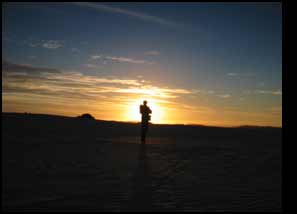 12.20.02
12.20.02
j: Tasmania West Coast.
A large portion of Tas is World Heritage designated national parks, combined with a low population of only about 500,000 for the island, makes for a quiet, mostly pastoral land with lots of roadkill on the "highways" that have absurdly high speed limits of 110 km/h (about 67 mph) for how windy and narrow they really are. Getting back to the parks, well, we're just more excited about the coastline. And there were some killer 100 foot high sand dunes on the west coast near Strahan, at least a half-mile wide at the narrowest point -- and if you've ever slogged through sand dunes, you'll realize we didn't make it to the waters edge before the beautiful sunset. The sand was so fine and clean on the dunes, almost soft even.
h: Strahan was a nice quiet little town. We stayed one evening to watch a concert put on by a neighboring town's concert band. The highlight of the evening was when Santa arrived to hand out treats to the town's kiddies - on a firetruck. Or, as Jan called it, the firegolfcart. It was so cute to see the truck pull up with all the kids running behind it... Christmas in a country with no snow, I guess.
|
|
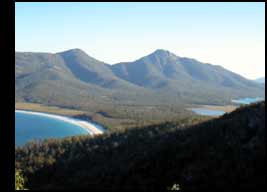 12.23.02
12.23.02
j: Tasmania East Coast.
On the final evening in Tas I decided I had to actually go on a walk in the parks, so I chose a walk to a scenic (coastal :-) lookout point in Freycinet Park on the east coast. The walk climbed 700 feet fairly quickly (not recommended in the rain) to view the tranquil and much-photographed Wineglass Bay, a sandy-banked isthmus on this peninsula, with peek-a-boo views back to the larger bay and little village where our hostel lay. And along the walk were huge granite boulders, looking as if a politically correct supreme entity had dropped his/her/its marbles. One of the boulders had broken off underneath, due to erosion through cracks, in such a way that the remaining boulder looked like a cresting wave (think of surfers in a half-pipe). Back at the hostel,we met yet more Germans (they're everywhere!). We had seen a few mozzies (mosquitoes) in the room earlier in the day and dutifully squashed them. I decided against busting out the bed-sized mosquito net, and ended up regretting it all night as I barely slept and was bitten multiple times, resulting in some big bumps... the moral of the story is, don't mess with mozzies.
|
|
|
12.28.02
h: Well, we're in Sydney visiting Guido, Jan's cousin. Jan hasn't a lot to say about this trip to Sydney since he got my headcold shortly after we arrived here and has had to forego some of the sightseeing to stay in bed. Guido has been a great tour guide, and as he gallantly pointed out it's in his name as you "need only change one letter".
We arrived in Sydney Christmas Eve and celebrated German-style with a nice Christmas evening dinner at a very nice fresh fish restaurant. Christmas Day, we feasted on a roast stuffed chicken prepared by our stylish host and went to the beach for the afternoon as is apparently tradition in Australia. The beach was pretty packed and people everywhere had amazing spreads of food as well as santa hats with their bikinis, blow-up Christmas trees, and we even saw Santa himself as he was coming in from a swim and putting his red suit back on to head for shore. We did a nice hike between Coogee Beach and Bondi Beach, which included a large cemetary right on the coast. A really great place to get buried if you ask me, overlooking the waves, but it looks like it hasn't been used in much of late.
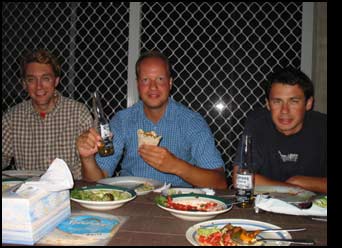 Boxing Day, what they call "the day after Christmas" in Commonwealth countries, Jan was under the weather so-to-speak, so Guido the Guide took me to Manly so we could try to catch a glimpse of the start of Australia's biggest annual yacht race - The Sydney to Hobart (Hobart is in Tasmania). We took a bus, then a ferry over to a penninsula only to discover we were not so well suited for viewing as we thought. We walked out to a mini-point to try for a better vantage but it started raining and by the time we got there we were soaked and people were leaving. When we arrived where people were sitting we asked if we'd missed anything and the reply was that they didn't know - we looked out to the strait where the race is supposed to begin but the storm that had moved in was so bleak that you couldn't see anything. Black clouds had come down to hang just over the water just at the start of the race so even the news crews in helicopters had a difficult time getting a view of the boats. Within the first half hour, two men overboard and two collisions.
Boxing Day, what they call "the day after Christmas" in Commonwealth countries, Jan was under the weather so-to-speak, so Guido the Guide took me to Manly so we could try to catch a glimpse of the start of Australia's biggest annual yacht race - The Sydney to Hobart (Hobart is in Tasmania). We took a bus, then a ferry over to a penninsula only to discover we were not so well suited for viewing as we thought. We walked out to a mini-point to try for a better vantage but it started raining and by the time we got there we were soaked and people were leaving. When we arrived where people were sitting we asked if we'd missed anything and the reply was that they didn't know - we looked out to the strait where the race is supposed to begin but the storm that had moved in was so bleak that you couldn't see anything. Black clouds had come down to hang just over the water just at the start of the race so even the news crews in helicopters had a difficult time getting a view of the boats. Within the first half hour, two men overboard and two collisions.
But the best part was, after we had dried off and gotten some lunch, the skies cleared a bit and we got on a ferry to head back to downtown. We were standing on the bow and CRASH, a wave hit that soaked me - only to be followed by a second one just seconds later. Guido, man of fast reflexes apparently, dived behind a railing and largely avoided both. I couldn't stop laughing.
A special thank you to Guido and his roommates for hosting us over the holidays. We very much enjoyed your company and wish you all the best in your own travels of Australia and your studies.
|
|
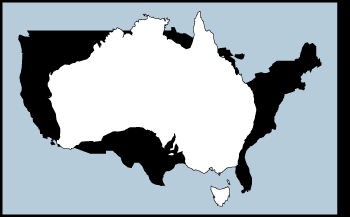 12.30.02
12.30.02
h: A Little About Australia.
Aside from my ferry adventure, Sydney has been leisurely and has given me the opportunity to compose some general observations about Australia. Here goes.
Australia is quite large. It is very similar in size and propportions to the continental United States - which I found rather mind- boggling. A flight across from Sydney to Perth - which we will undertake shortly - takes nearly as long as a New York to Seattle flight does.
Food in Australia is very similar to that of England (largely bland and overcooked) but fortunately unlike England, Australia has some spice-loving neighbors which are making their mark on Australian cuisine. Jan and I looked high and low for some fish that wasn't deep fried and apparently it's just not done here. Fresh fish in general seems more difficult to come by than you would expect for an island continent, but when you finally do find some it seems it's nearly always coated with beer batter and deep fried to be served with chips. We have heard of this Australian thing called the Barbie, but apparently it is meant for grilling kangaroo rump and English pork sausages.
The first people of Australia showed up here some 40,000 years ago and by interesting coincidence at around the same time the fossil record shows that all of the continent's megafauna (giant marsupial equivalents of cows and rhinoceroses, giant kangaroos, and giant wombats) became extinct. This was, either as a coincidence or because the humans hunted them to extinction, a rather unfortunate thing since this left Australian Aborigines with no large mammals for domestication as was going on in other parts of the world over time. With no large mammals to domesticate, they never established farming communities and remained largely as hunter-gatherers using very basic stone technology until the arrival of the Europeans. Having no metal technologies and no resistance to the germs brought by the Europeans (also the result of mammal domestication since most of our epidemic diseases have adapted to humans as a result of keeping livestock), the Aborigines suffered the same fate as the Native Americans for the most part; they were conquered and their land was divided amongst the new European inhabitants.
As places go, Australia is pretty hostile. Not the people - as I've mentioned before, the people seem outstandingly friendly and willing to bend over backward to give you directions to the bus stop. No, it's the land, you see. A very strange and interesting place. To steal a few factoids... most of Australia receives less than 20 inches of rainfall per year and even its largest river system has been known to go bone dry in years of severe drought. Droughts are part of the climatic cycle of Australia as it does not have an annual cycle as does most of the rest of the world. Unpredictable droughts will last for years and then suddenly be followed by torrential floods and downpours - making even modern-day agriculture a very risky and precarious endeavor. Australia is also very flat - 94 percent of its area lies below 2000 ft of elevation - and it has virtually no high mountains or glaciers or volcanos. As a result, it has great fossils (little disruption over such a long time) but very nutrient-poor and shallow soils (none of the volcanos or glaciers which created the fertile soils of Europe and North America).
Australia is the sixth largest country and the only country that is both and island and its own continent. It is a continent full of deadly things - of the world's ten most deadly snakes, five of them inhabit Australia. Five of its creatures - funnel web spider, box jellyfish, blue-ringed octopus, paralysis tick, and stonefish - are the most lethal of their type in the world and this leaves out the obvious sharks and crocodile that will merely chomp you to death. Eighty percent of the species in Australia live only in Australia and can be found no where else in the world and scientists don't even know how many species exist of insects, much less have names and classifications for all of them.
But the most formidable opponent I have met here is the sun. It is uncomfortable just to sit in it. A fully overcast day can still result in a nasty sunburn. The sun here is strong.
I had heard about Australia's anti-sunburn campaign ages ago - due to their centralized medical system the goverment deemed it a worthy expenditure to teach children in schools about the risks of skin cancer and try to give them good habits from a young age. The popular campaign you see everywhere here is "Slip, Slop, Slap" which stands for Slip on a shirt, Slop on some sunscreen, and Slap on a hat and apparently it's been going for some twenty years. And when we arrived I saw children playing in school yards when you drive by are ALL wearing sunhats as they learn these strange sports called cricket and Aussie rules football. What I didn't realize is that the sun actually IS stronger here - a strange problem about a hole in the ozone. It's not simply that people are out in the sun more here, or that there are more sunny days (although both of these seem true as well), but the sun actually is stronger here. And if my sources are to be trusted (Guido), 2 out of 3 Australians get some form of skin cancer at some point in their life. Wow.
Now that I've painted a bleak image of a dry, sunbaked island full of poisonous creatures... I think it's time to shift to something a little more positive, perhaps. Australia is truly beautiful, what I've seen of it, and pretty diverse. Arid forests, grasslands, coastal wetlands, tropical rainforests, deserts. And with such a small population compared to Europe or North America, it's STILL beautiful. Australians seem to take care of their land a little better than we do; I have a hard time imagining that the penguins would still be coming up every night as they had done for thousands of years if it was Americans rather than Aussies who were running the show. Despite this diversity of climate, Australia is largely missing most tropical diseases such as malaria or yellow fever, and even rabies has not made it through their quarantine. Their health standards seem to be stricter in some cases than the United States (a restaurant in Melbourne told us that we could not take our leftovers with us because it was a violation of the city's health code laws) and their medical care is classified as excellent. Australia is clean, tolerant, thoroughly modern, and once again, friendly. It is easy to travel and there are many conveniences set up just for the intinerants such as ourselves who come to the land down under to see what there is to see. There are hostels and cheap accomodation everywhere, the cities are safe, and everything a traveller could need is easy to find and usually competitively priced. In fact, the traveller is so well accomodated here, it feels a bit like cheating. Like there's nothing to figure out, screw up, or have problems with... and what is a trip without getting ripped off, not being able to find something you need, or getting lost... ?
Hmmm. Must be a trip to Australia.
|
|
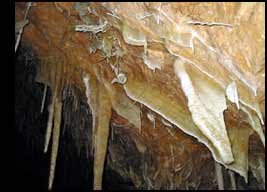 1.3.03 - 1.7.03
1.3.03 - 1.7.03
j: Southwest of Perth.
So we decide to take a 3 day hop-on/hop-off tour called Easyriders, extending it by 2 extra nights to avoid overload/exhaustion. Day 1 includes stops at a beach/park where the driver made tea and coffee, a beach in Bunbury where the dolphins come up (we just missed them by 5 minutes), a beach with lots of flies for our brown bag lunch break, a fly-less cave with lots of stalactite formations including fan-shaped ones, a slightly stuffy wine tasting at one of the dozens of wineries in the Margaret River region (mmm-mmm good and yes, we bought two bottles :-), and a beach where surfers and kite-surfers rule for a not-quite-sunset view of the surfing action.
Day 2 was an extra day/night we took to relax and do the Bushtuckers canoe/cave/lunch tour. Now "tucker" refers to food, so bushtucker is bush food, i.e. stuff the aborigines ate. The river canoeing and small cave tour weren't all that exciting to me. But the lunch was very tasty, including things akin to raisins, dried tomatoes and pepper corns; smoked kangaroo and emu meat; 3 plants that grow in the sand dunes including one like bitter lettuce called "rocket," one salty rosemary, and one like spinach; some unleavened-bread-like-substance made from crushed nuts and water; a nut; a lychee-like fruit with a brain-like pit containing an edible macadamia-like nut; a chutney-like, uh, chutney; and last but not least, a paste made from grubs (and spices).
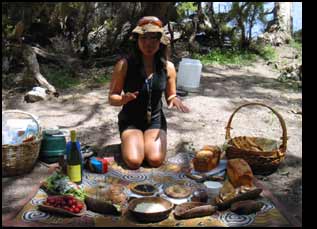 Actually all of it was palatable, and a lot of it was quite tasty! The food was not all local to the area, but comes from around Australia. And what would a picnic be without ants, or at least one lone big-ass ant that we later found out it was a bull ant crawling between us. That evening I played pool with some winemaking student Sydney-siders out here on their summer vacation doing research ... while drinking beer, hmm, how serious a wine student were they? and learned how to jam the coin-op pool table so as to play for free after the first game.
Actually all of it was palatable, and a lot of it was quite tasty! The food was not all local to the area, but comes from around Australia. And what would a picnic be without ants, or at least one lone big-ass ant that we later found out it was a bull ant crawling between us. That evening I played pool with some winemaking student Sydney-siders out here on their summer vacation doing research ... while drinking beer, hmm, how serious a wine student were they? and learned how to jam the coin-op pool table so as to play for free after the first game.
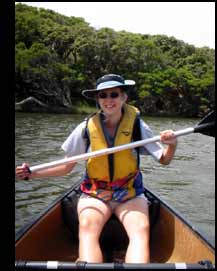 Day 3 was back on the bus early in the morning, with a different driver and a somewhat different group of riders due to the hop-on/off nature. I got the hairy eyeball from a gal whose seat I seemed to take, though she wasn't around -- like her hat on the floor from the night before is enough to claim a seat! First we stopped for tea and coffee near a lighthouse at Cape Leewin where the Indian and Southern Oceans meet. The next stop was a fire lookout tree, the Gloucester tree (named after some British duke or something visited, yeah, whatever), a type of eucalyptus, which they let people climb. Basically what they have is a lookout tower 62m (about 200 feet or 20 stories) off the ground, near the top of the tree -- well, they sawed the top of the tree off where the trunk was still a good foot in diameter, but still, that's pretty high up. Now here comes the fun part (and what wouldn't fly in liability-crazy USA, though apparently Australia is having more and more liability lawsuit problems) -- you have to climb up what amounts to a ladder of rebar sticking out of the side of the tree, spiraling up near-vertical, with the rungs being a good foot apart.
Day 3 was back on the bus early in the morning, with a different driver and a somewhat different group of riders due to the hop-on/off nature. I got the hairy eyeball from a gal whose seat I seemed to take, though she wasn't around -- like her hat on the floor from the night before is enough to claim a seat! First we stopped for tea and coffee near a lighthouse at Cape Leewin where the Indian and Southern Oceans meet. The next stop was a fire lookout tree, the Gloucester tree (named after some British duke or something visited, yeah, whatever), a type of eucalyptus, which they let people climb. Basically what they have is a lookout tower 62m (about 200 feet or 20 stories) off the ground, near the top of the tree -- well, they sawed the top of the tree off where the trunk was still a good foot in diameter, but still, that's pretty high up. Now here comes the fun part (and what wouldn't fly in liability-crazy USA, though apparently Australia is having more and more liability lawsuit problems) -- you have to climb up what amounts to a ladder of rebar sticking out of the side of the tree, spiraling up near-vertical, with the rungs being a good foot apart.
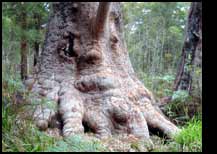 Yes, there's a flimsy little net behind you, but otherwise not much to stop you from falling a good ways down, and taking out the people under you. Well, they do limit the number of people who can climb at once, but still... The view at the top wasn't really all that exciting, more treetops and you can see a distance around you, but the climb was exhilirating and a little scary I readily admit. Going back down was easier and faster, but I could definitely feel my thigh muscles afterwards. Next stop was a tree-top walk (hmm, sense a theme here?) which was basically a wheelchair-accessible catwalk suspended up to 40m (130 feet) in the air near the top of the tree canopy of a different kind of eucalyptus forest. Oddly enough, the free walk along the forest bottom was actually more interesting than the paid-entry tree-top walk, partly because these eucalypti have wide often hollowed-out bases. A few hours later our big yellow tour bus emerged on the scenic coast, where we stopped to look at the aptly-named elephant rocks, as well as Greens Pool, a calm protected "pool" of cool water. Finally we arrive at our hostel in Albany, in the nick of time for the nightly free cake and coffee at 6:30pm. That night we went for the hostel's dinner which happened to be a roast with gravy, potatoes, peas, carrots, Yorkshire pudding, dessert and red wine (can you say home-cooked meal?) all for AUD$8.50 - that's almost USD$5 each. We even scored an extra 1/2 carafe of wine, and some delicious prawns from an older Swedish couple, whose Swedish dialect was at first unrecognizable as Swedish to the Swedish guy who sat between us - and he at it turned out only lived 200km away from these people!
Yes, there's a flimsy little net behind you, but otherwise not much to stop you from falling a good ways down, and taking out the people under you. Well, they do limit the number of people who can climb at once, but still... The view at the top wasn't really all that exciting, more treetops and you can see a distance around you, but the climb was exhilirating and a little scary I readily admit. Going back down was easier and faster, but I could definitely feel my thigh muscles afterwards. Next stop was a tree-top walk (hmm, sense a theme here?) which was basically a wheelchair-accessible catwalk suspended up to 40m (130 feet) in the air near the top of the tree canopy of a different kind of eucalyptus forest. Oddly enough, the free walk along the forest bottom was actually more interesting than the paid-entry tree-top walk, partly because these eucalypti have wide often hollowed-out bases. A few hours later our big yellow tour bus emerged on the scenic coast, where we stopped to look at the aptly-named elephant rocks, as well as Greens Pool, a calm protected "pool" of cool water. Finally we arrive at our hostel in Albany, in the nick of time for the nightly free cake and coffee at 6:30pm. That night we went for the hostel's dinner which happened to be a roast with gravy, potatoes, peas, carrots, Yorkshire pudding, dessert and red wine (can you say home-cooked meal?) all for AUD$8.50 - that's almost USD$5 each. We even scored an extra 1/2 carafe of wine, and some delicious prawns from an older Swedish couple, whose Swedish dialect was at first unrecognizable as Swedish to the Swedish guy who sat between us - and he at it turned out only lived 200km away from these people!
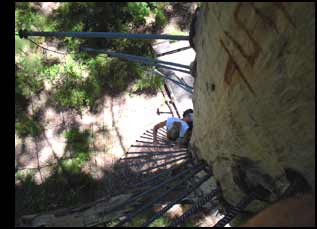 Day 4 was a lazy day again. We ended up doing a short morning tour on the bus to avoid doing it the next day just before returning to Perth, which would be a long boring drive in and of itself. We visited the nearby coast to look at "The Gap," a 40m (130ft) gap in the stone cliffs, as well as an arch called the Natural Bridge, a "squeaky" beach with a high silica content, and yet another beach for a coffee stop. The blowholes weren't -- apparently bigger swells are needed in the ocean, and we suspect that only happens in the winter time (remember, it's summer down here :-) nor was it even very windy.
Day 4 was a lazy day again. We ended up doing a short morning tour on the bus to avoid doing it the next day just before returning to Perth, which would be a long boring drive in and of itself. We visited the nearby coast to look at "The Gap," a 40m (130ft) gap in the stone cliffs, as well as an arch called the Natural Bridge, a "squeaky" beach with a high silica content, and yet another beach for a coffee stop. The blowholes weren't -- apparently bigger swells are needed in the ocean, and we suspect that only happens in the winter time (remember, it's summer down here :-) nor was it even very windy.
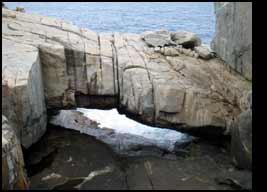 A bit of shopping but otherwise a lazy day. Once again, a nice meal at the hostel, this time a BBQ including roo (i.e. kangaroo, aka skippy). We decided that non-YHA hostels aren't quite as nice, but have more atmosphere. In this hostel all the rooms had painting on the wall; ours was a huge lizard on a tree branch, along with a snake starting to swallow a black lizard. Oddly enough, earlier in the afternoon, during our prawn lunch (I just had to get more of those prawns the Swedes had the night before) a black lizard not unlike the one in the wall painting came up almost to our feet, and did in fact munch a few prawn heads we threw to him/her/it.
A bit of shopping but otherwise a lazy day. Once again, a nice meal at the hostel, this time a BBQ including roo (i.e. kangaroo, aka skippy). We decided that non-YHA hostels aren't quite as nice, but have more atmosphere. In this hostel all the rooms had painting on the wall; ours was a huge lizard on a tree branch, along with a snake starting to swallow a black lizard. Oddly enough, earlier in the afternoon, during our prawn lunch (I just had to get more of those prawns the Swedes had the night before) a black lizard not unlike the one in the wall painting came up almost to our feet, and did in fact munch a few prawn heads we threw to him/her/it.
Day 5 was a lazy morning followed by a boring 6 hour overland direct drive back to Perth, with no touristy sites, just a few loo breaks. Boy was it hotter in Perth than down the coast, up around 30°C (86 F) when we stepped off the bus. Back in Freo we ate dinner on Cappucino Strip -- which is actually Market Street, but it's called the former due to all the cafes and restaurants -- outside in the shade, where I indulged in seafood yet again; 1 kg (2.2 lbs) of mussels in a "chilli sauce," a spicy tomato sauce would be more accurate. It's a rough life. The diet starts tomorrow ;-)
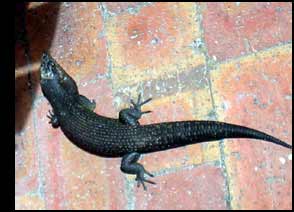 h: Our first driver was called Phil and he was a former urban planner whose last job before tour guide driver was teaching English in Thailand. He was mellow and his descriptions of local politics and environmental matter reflected his liberal and at the same time urban-planner backrounds. He played the best music. The second driver was called Garrett. Originally from Northern Ireland, he had his cousin Katy in tow who was visiting from Northern Ireland. Katy was bright red from a nasty sunburn and spent the day with a look on her face that this was someone else's idea and she was doing her best to have fun but it all seemed so Bright and Tiresome. Garrett was good energy - the ultimate diplomat whose never-waivering enthusiasm was inspiring. And then there was Mic. Our third driver. Blond, surfer dude - America's idea of an embodiment of everything that is Australian. He did the six hour stint back to Perth - hot as hell and in nearly total silence as everyone sweatted and slept their way back to the city. He gave Jan and I a book called Chopper3 to read which is actually written by an Australian criminal/folk hero. Pretty gruesome but interesting nonetheless. Mic's best line was "Shut your wordhole, woman" to this mouthy girl from Poland. The English twenty-something boys in the back of the bus thought this was just FAB-u-LOUS.
h: Our first driver was called Phil and he was a former urban planner whose last job before tour guide driver was teaching English in Thailand. He was mellow and his descriptions of local politics and environmental matter reflected his liberal and at the same time urban-planner backrounds. He played the best music. The second driver was called Garrett. Originally from Northern Ireland, he had his cousin Katy in tow who was visiting from Northern Ireland. Katy was bright red from a nasty sunburn and spent the day with a look on her face that this was someone else's idea and she was doing her best to have fun but it all seemed so Bright and Tiresome. Garrett was good energy - the ultimate diplomat whose never-waivering enthusiasm was inspiring. And then there was Mic. Our third driver. Blond, surfer dude - America's idea of an embodiment of everything that is Australian. He did the six hour stint back to Perth - hot as hell and in nearly total silence as everyone sweatted and slept their way back to the city. He gave Jan and I a book called Chopper3 to read which is actually written by an Australian criminal/folk hero. Pretty gruesome but interesting nonetheless. Mic's best line was "Shut your wordhole, woman" to this mouthy girl from Poland. The English twenty-something boys in the back of the bus thought this was just FAB-u-LOUS.
|
|
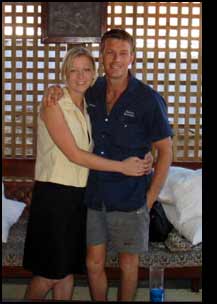 1.14.03
1.14.03
h: Jan and I have spent the last week as guests at a lovely, Federation-style architecture home complete with stained glass (more precisely, leadlights), antique furnishings, and three charming kitties. A plush B&B you ask? Did we say to hell with the budget and book ourselves in for a little luxury? No, actually. We've been kindly and graciously hosted by Kim and Ashley, and their home is like a museum. Absolutely amazing. Ashley is trained as a leadlighter and the windows in his home are evidence of his talent. Ashley and Kim's current project is that they are starting an import business, bringing in leadlight lamps and suncatchers from China. It is a big endeavour and we wish them the best in it and offer our sincerest thanks for their excellent hospitality. (biggest, softest bed in Australia for us!).
I met Kim when I was travelling in Canada and it's been a longtime pursuit of mine to make it out to Perth to visit her. Apparently, with all the folks she's met during her few-years-travel around the world, not too many have made it to this far-away corner. Perth, population of about 1.5 million, is the most isolated city in the world. It was a 5 hour flight from Sydney across Australia's interior and when we fly out today for Kuala Lumpur it will take about 5 hours as well. You can get to Perth by train, but it takes 3 days and nights from Sydney and there really is pretty much nothing in between. No matter how you look at it, Perth is very far away.
Jan and I found Perth and nearby port-town Fremantle really lovely. We were not particular active tourists in this part of our trip, but we did get out to see Freo (local for Fremantle) which has some interesting historic sites and a very good historic marine museum. They actually pulled up a section of a hull from a ship from a century-old wreck and cured it so they could put it on display in the museum. Shipwrecks are a big part of local historic lore in this part of the world; many came here seeking their fortune and the area was on the trade routes over the Indian Ocean. Many got wealthy, many drowned. The coast is littered with wrecks, some for diving, some not.
Fremantle achieved some world-wide notoriety nearly 20 years ago when it was host to the America's Cup after a Fremantle-based vessel took the trophy away from the US who had been bringing it home for years. The winning yacht had a newly-designed keel that was not announced before the start of the race and thus subject to some controversy once the trophy was taken. Freo built a new Maritime Museum with an interesting exhibit on the subject, also very interesting architecture. Personally I liked the historic museum better, but to each his, or her, own.
We spent a day cruising around downtown Perth and spent a little time looking at a megamouth (species of shark that has only been captured a handful of times by scientists) in a vat of alcohol, an 11-tonne meteorite, and a blue whale skeleton that had been set up so you could walk under and around it. Really gives you a sense of how large these whales are.
But the highlight for us, by far, was our two days on Scarborough Beach enjoying the wicked sun, the cool breezes, the white sand and the WARM Indian Ocean. Finally! Warm water. Okay, warm is exaggerating a bit, but it's not COLD, and that's fine by me. We are off now to the airport for the beaches of Malaysia, Thailand, Cambodia, and Vietnam and looking forward to every minute of it. Cheers, Australia. See you in 6 weeks.
|
|
|
Want to see more pictures? Check out these slide shows.
|
|
|
Next country: Malaysia.
|
|
 |

